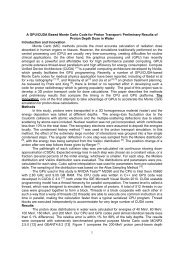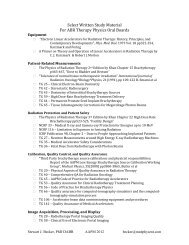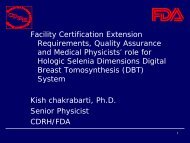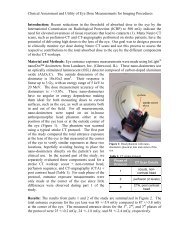Electron Radiotherapy Past, Present & Future
Electron Radiotherapy Past, Present & Future
Electron Radiotherapy Past, Present & Future
Create successful ePaper yourself
Turn your PDF publications into a flip-book with our unique Google optimized e-Paper software.
<strong>Electron</strong> <strong>Radiotherapy</strong><br />
<strong>Past</strong>, <strong>Present</strong> & <strong>Future</strong><br />
John A. Antolak, Ph.D., Mayo Clinic,<br />
Rochester MN<br />
Kenneth R. Hogstrom, LSU, Baton Rouge, LA
Conflict of Interest<br />
John A. Antolak<br />
N/A<br />
Disclosure<br />
Kenneth R. Hogstrom<br />
Research funding from Elekta, Inc.<br />
Research funding from .decimal, Inc.
Learning Objectives<br />
1. Learn about the history of electron radiotherapy that is relevant<br />
to current practice.<br />
2. Understand current technology for generating electron beams<br />
and measuring their dose distributions.<br />
3. Understand general principles for planning electron<br />
radiotherapy<br />
4. Be able to describe how electron beams can be used in special<br />
procedures such as total skin electron irradiation and<br />
intraoperative treatments.<br />
5. Understand how treatment planning systems can accurately<br />
calculate dose distributions for electron beams.<br />
6. Learn about new developments in electron radiotherapy that<br />
may be common in the near future.
History, KRH<br />
Outline<br />
Machines & Dosimetry, JAA<br />
Impact of heterogeneities, KRH<br />
Principles of electron planning, KRH<br />
Special Procedures, JAA<br />
<strong>Electron</strong> Dose Calculations, JAA<br />
Looking to the <strong>Future</strong>, JAA
History of <strong>Electron</strong><br />
Therapy<br />
Kenneth R. Hogstrom, Ph.D.
Clinical Utility<br />
• <strong>Electron</strong> beams have been successfully used in numerous<br />
sites that are located within 6 cm of the surface:<br />
– Head (Scalp, Ear, Eye, Eyelid, Nose, Temple, Parotid, …)<br />
– Neck Node Boosts (Posterior Cervical Chain)<br />
– Craniospinal Irradiation for Medulloblastoma (Spinal Cord)<br />
– Posterior Chest Wall (Paraspinal Muscle Sarcomas)<br />
– Breast (IMC, Lumpectomy Boost & Postmastectomy CW)<br />
– Extremities (Arms & Legs)<br />
– Total Skin <strong>Electron</strong> Irradiation (Mycosis Fungoides)<br />
– Intraoperative (Abdominal Cavity) and Intraoral (Base of Tongue)<br />
– Haas et al (1954); Tapley (1976); Vaeth & Meyer (1991)<br />
• <strong>Electron</strong> beam utilization peaked early 1990s<br />
≈15% of patients at MDACC received part of radiotherapy with e -<br />
History of <strong>Electron</strong> Therapy
History of <strong>Electron</strong> Therapy<br />
Accelerator Technology<br />
• Van de Graaff Accelerators (late 1930s)<br />
E
History of <strong>Electron</strong> Therapy<br />
Accelerator Technology<br />
• Betatrons (late 1940s)<br />
Developed in US (Kerst) and Germany (Glocker) (circa 1940)<br />
Beam line and dosimetry development: 6
History of <strong>Electron</strong> Therapy<br />
Accelerator Technology<br />
• Linear Accelerators (1960s)<br />
1968: 137 betatrons/79 linacs (only few had e-)<br />
Post WWII RF amplifiers (magnetron & klystrons)<br />
1960s-present: Traveling wave & side-coupled standing wave<br />
Karzmark & Morton 1989 & Karzmark et al 1993<br />
History of <strong>Electron</strong> Therapy
History of <strong>Electron</strong> Therapy<br />
Accelerator Technology<br />
• Phasing Out of Orthovoltage (kVp) X-ray Machines<br />
Replaced by Cobalt-60 (late 1950-60s) & linacs (1970s)<br />
<strong>Electron</strong>s became the replacement modality for skin cancers<br />
• Loss of Scanned Beams (1985-1990)<br />
%DD of scanned beams superior to scattered beams<br />
AECL Therac 25 accidents (5 die; others injured)<br />
GE repair of CGR Sagittaire in Zaragosa (18 die; 9 injured)<br />
Scanditronix microtron accelerators failed in marketplace (1990s)<br />
History of <strong>Electron</strong> Therapy<br />
(www.dotmed.com)
History of <strong>Electron</strong> Therapy<br />
Accelerator Technology<br />
• Manufacturers Offer Comparable <strong>Electron</strong> Beams<br />
New units mostly Elekta and Varian; Siemens similar quality beams<br />
Multiple electron beams: 7-8 in range 6-20 MeV<br />
Special modalities: High dose rate TSEI & <strong>Electron</strong> arc therapy<br />
Varian Trilogy<br />
(www.varian.com)<br />
History of <strong>Electron</strong> Therapy<br />
Elekta Infinity<br />
(www.elekta.com)
History of <strong>Electron</strong> Therapy<br />
Dose Calculation & Measurement Technology<br />
• <strong>Electron</strong> Transport and Dose Calculations<br />
ICRU 35 (1984) and Use of Fermi-Eyges Theory (1980s)<br />
Monte Carlo: EGS4, BEAM, DOSXYZ (1985-1995)<br />
• Dose Measurement Protocols<br />
AAPM TG Reports 21, 39, & 51 (Dose Calibration)<br />
AAPM TG Reports 25 & 70 (Relative Dose Measurements)<br />
• Treatment Planning<br />
CT-Based Planning: GE Target TPS (1981)<br />
Pencil-beam Dose Calculations: GE Target TPS (1983)<br />
3D Treatment Planning Systems (late 1990s)<br />
Bolus <strong>Electron</strong> Conformal Therapy (2000s)<br />
History of <strong>Electron</strong> Therapy
<strong>Electron</strong> Beam Therapy<br />
Impediments to Clinical Use<br />
• Inadequate Education of Treatment Team<br />
Administrators, Radiation Oncologists<br />
Medical Physicists and Medical Dosimetrists<br />
• Lack of Marketing by Vendors<br />
Treatment Techniques<br />
Varian offers the latest advanced treatment techniques in radiation therapy today:<br />
• RapidArc: RapidArc radiotherapy technology delivers uncompromised treatment in two<br />
minutes or less.<br />
• IGRT: Image-guided radiation therapy pinpoints a moving target.<br />
• IMRT: Intensity-modulated radiation therapy structures the dose to spare healthy tissue.<br />
• DART: DART dynamic adaptive radiation therapy adapts treatment to changing needs.<br />
• IGBT: Image-guided brachytherapy implants radiation quickly and precisely.<br />
• Proton Therapy: Proton therapy focuses on tumor shape to avoid critical structures.<br />
• Competing Technologies<br />
• Lack of Commercially Available Technology<br />
History of <strong>Electron</strong> Therapy
Competing Technology<br />
Examples<br />
• Helical TomoTherapy<br />
Chest Wall<br />
Scalp<br />
Craniospinal<br />
Head and Neck<br />
• Proton Therapy<br />
Craniospinal, H&N<br />
• HDR Brachytherapy<br />
Lumpectomy Boost<br />
Intraoperative Therapy<br />
History of <strong>Electron</strong> Therapy<br />
Ashenafi et<br />
Ashenafi et al 2010<br />
Mu et al 2005
Leveling the Playing Field<br />
Missing Integrated Technologies<br />
• Fixed Beam Therapy Lacks:<br />
Treatment planning tools for segmented field e - conformal therapy<br />
Treatment planning tools for modeling treatment aids<br />
Updated pencil beam (redefinition) algorithm<br />
Integrated, retractable eMLC for treatment delivery<br />
• <strong>Electron</strong> Arc Therapy Lacks:<br />
Treatment planning tools (2º & 3º collimator design, energy<br />
segmentation, bolus design, dose & MU calculations)<br />
Use of dynamic MLC for dose optimization<br />
• Total Skin <strong>Electron</strong> Irradiation Lacks:<br />
Configuration of beam delivery system<br />
Treatment stand<br />
History of <strong>Electron</strong> Therapy
Leveling the Playing Field: Missing<br />
Technologies- Treatment Planning Tools<br />
Tapley et al 1976<br />
(1) Bolus scatter plate not modeled<br />
(2) Surface dose calculation inaccurate<br />
(3) Backscatter dose calculation inaccurate<br />
(4) Eyeshield not modeled<br />
(5) Skin collimation not modeled<br />
Squamous Cell Carcinoma<br />
PTV=Red Volume<br />
(6) Penumbra calculation inaccurate
Machines & Dosimetry<br />
John A. Antolak, Ph.D.
Linac Head<br />
Karzmark, C. J., Nunan, C.S., Tanabe, E: Medical <strong>Electron</strong> Accelerators, McGraw Hill, 1992.<br />
Machines & Dosimetry
<strong>Electron</strong> Mode<br />
Karzmark, C. J., Nunan, C.S., Tanabe, E: Medical <strong>Electron</strong> Accelerators, McGraw Hill, 1992.<br />
Machines & Dosimetry
Dual Scattering Foils<br />
Karzmark, C. J., Nunan, C.S., Tanabe, E: Medical<br />
<strong>Electron</strong> Accelerators, McGraw Hill, 1992.<br />
Machines & Dosimetry
<strong>Electron</strong> Collimation<br />
Applicators with<br />
Inserts<br />
Variable Trimmers<br />
Intracavitary Cones<br />
Intraoperative<br />
radiotherapy cones<br />
Intraoral Cones<br />
Transvaginal cones<br />
Systems<br />
Machines & Dosimetry
Applicators (Cones)<br />
Hogstrom K.R., Meyer J.A, and Melson R. Variable electron collimator for the Mevatron 77: design and dosimetry.<br />
In: Proceedings of the 1985 Mevatron Users Conference, pp. 251-276, Iselin NJ; Siemens Medical Systems, 1985.<br />
Machines & Dosimetry
Dosimetry
TG71: Ion Chamber<br />
Dosimetry<br />
Leakage < 0.1%<br />
Effective point of measurement<br />
0.5 r shift for cylindrical chambers<br />
was 0.75 r in TG21<br />
No shift (inside front electrode) for parallel plate<br />
Stopping power ratio<br />
Burns equation (first used in TG51)<br />
Fluence correction (Table 1, same as TG21,<br />
TG25)<br />
P wall , P ion and P pol “ignored”<br />
Machines & Dosimetry
Diodes<br />
TG71: Other<br />
Considerations<br />
Directly gives dose, but should be checked<br />
versus correct ion chamber curves<br />
Scanning Water Phantoms<br />
May not implement all recommended<br />
correction factors when converting<br />
ionization to dose<br />
Need to verify<br />
Machines & Dosimetry
(100%)<br />
% Depth Dose<br />
R 10 −R 90<br />
AAPM TG-25<br />
Report<br />
(1991)<br />
Machines & Dosimetry 10
10-20 MeV <strong>Electron</strong>s in<br />
Water<br />
Machines & Dosimetry
Side-scatter Equilibrium<br />
In-scatter Out-scatter<br />
Machines & Dosimetry<br />
Side-scatter<br />
equilibrium exists if<br />
the electron fluence<br />
scattered away from<br />
a small area in the<br />
vicinity of a point is<br />
replaced by electrons<br />
scattering into that<br />
area.
Side-Scatter Equilibrium<br />
(homogeneous phantom)<br />
All of the electrons that can<br />
reach the point of interest are<br />
let through<br />
Side-scatter equilibrium exists!<br />
R 100<br />
Reference geometry<br />
Machines & Dosimetry<br />
Some of the electrons that can<br />
reach the point of interest are<br />
blocked<br />
Side-scatter equilibrium does<br />
not exist!<br />
R 100<br />
Reduced field size
Depth Dose Energy<br />
Dependence (6-20 MeV)<br />
Machines & Dosimetry<br />
As energy increases<br />
Surface dose (D s )<br />
increases (70%-90%)<br />
Therapeutic depth (R 90 )<br />
increases<br />
Dose falloff (R 10 -R 90 )<br />
increases<br />
Practical range (R p )<br />
increases<br />
Bremsstrahlung dose<br />
(D x ) increases<br />
Small variations due to<br />
method of beam flattening<br />
and collimation
% Depth Dose<br />
Field Size Dependence<br />
E=9 MeV<br />
Machines & Dosimetry<br />
As field size decreases<br />
Therapeutic depth (R90)<br />
decreases<br />
Surface dose (DS)<br />
increases<br />
Practical range (Rp)<br />
remains constant<br />
Decrease in R90 less<br />
significant at lower<br />
energies<br />
Increase of DS more<br />
significant at lower<br />
energies
% Depth Dose<br />
Field Size Dependence<br />
E=20 MeV<br />
Machines & Dosimetry<br />
As field size decreases<br />
Therapeutic depth (R90)<br />
decreases<br />
Surface dose (DS)<br />
increases<br />
Practical range (Rp)<br />
remains constant<br />
Decrease in R90 more<br />
significant at higher<br />
energies<br />
Increase of DS almost<br />
insignificant at higher<br />
energies
% Depth Dose<br />
Applicator Dependence<br />
20 MeV<br />
10x10 Insert<br />
Machines & Dosimetry
Square-Root Rule<br />
% Depth Dose of Rectangular Field<br />
[ ( ) ]<br />
%DD L,W ( d)<br />
= %DD L,L ( d)<br />
×%DD W ,W d<br />
%DD L,W (d) is percent dose<br />
at depth d for rectangular<br />
field of dimensions L by W<br />
Note: the resultant %DD<br />
curve must be normalized<br />
such that its D max =100%<br />
1 2<br />
Machines & Dosimetry
% Depth Dose<br />
SSD Dependence<br />
Inverse Square- small impact due to:<br />
SSD>110 cm is seldom used<br />
Dose is superficial (d
Off-Axis Dose (Penumbra)<br />
Field Size Dependence<br />
Penumbra is the edge of the<br />
beam for which there is not sidescatter<br />
equilibrium<br />
Penumbra width is a measure of<br />
penumbra shape<br />
P90-10=distance from 90% to<br />
10% OAR<br />
P80-20=distance from 80% to<br />
20% OAR<br />
Penumbra width remains<br />
constant as field size increases<br />
once there is side-scatter<br />
equilibrium on central axis.<br />
Machines & Dosimetry
Off-Axis Dose<br />
Energy & Depth Dependence<br />
Penumbra width<br />
at depth of R 90<br />
increases with<br />
energy<br />
Machines & Dosimetry<br />
Penumbra at surface<br />
is sharper at higher<br />
energies<br />
Penumbra increases<br />
quickly for depth < R 90<br />
Penumbra constant<br />
(or getting smaller)<br />
for depth > R 90
Off-Axis Dose SSD<br />
Dependence<br />
6 MeV, 100-cm SSD<br />
6 MeV, 110-cm SSD<br />
Machines & Dosimetry<br />
Penumbra width at<br />
surface increases in<br />
proportion to air gap<br />
(distance from final<br />
collimating device to<br />
patient, SSD-SCD)<br />
Penumbra width at<br />
depth of R 90<br />
increases<br />
significantly for lower<br />
electron energies
Off-Axis Dose SSD<br />
Dependence Penumbra width at<br />
surface increases in<br />
proportion to air gap<br />
(distance from final<br />
collimating device to<br />
patient, SSD-SCD)<br />
16 MeV, 100-cm SSD<br />
16 MeV, 110-cm SSD<br />
Machines & Dosimetry<br />
Penumbra width at<br />
depth of R 90<br />
increases little for<br />
higher electron<br />
energies
Impact of Patient<br />
Heterogeneity on Dose<br />
Distribution<br />
Kenneth R. Hogstrom, Ph.D.
Influence of Patient Anatomy<br />
on <strong>Electron</strong> Dose Distributions<br />
How do electron dose distributions in<br />
patients differ from those in water?<br />
Impact of Patient Heterogeneity
Influence of Patient Anatomy<br />
on <strong>Electron</strong> Dose Distributions<br />
• Patient Surface<br />
Oblique incidence<br />
Irregular Surface<br />
• Internal Heterogeneities<br />
Bone<br />
Air<br />
Lung<br />
Impact of Patient Heterogeneity
Effects of Oblique Incidence on<br />
<strong>Electron</strong> Dose Distribution<br />
Penumbra<br />
Impact of Patient Heterogeneity<br />
• decreases for<br />
surfaces closer<br />
to source<br />
• increases for<br />
surface further<br />
from sources
Ekstrand and<br />
Dixon (1982)<br />
Effect of Oblique Incidence on<br />
<strong>Electron</strong> Dose Distribution<br />
Depth Dose<br />
• Surface dose (D s ) increases<br />
• Depth of maximum dose (R 100 )<br />
decreases<br />
• Maximum dose (D max ) increases<br />
• Therapeutic depth (R 90 ) decreases<br />
• Depth of maximum penetration (R p )<br />
increases<br />
• Effects become more severe as<br />
angle from ⊥ increases<br />
Impact of Patient Heterogeneity
Effect of Irregular Surface on<br />
<strong>Electron</strong> Dose Distribution<br />
13 MeV, 10 x 10 cm 2 , 100 cm SSD<br />
Depression (e.g. ear canal, surgical defect)<br />
• Increased dose in shadow of depression<br />
• Decreased dose around its periphery<br />
Impact of Patient Heterogeneity
Morrison et al 1995<br />
Squamous Cell CA of Concha<br />
Impact of Patient Heterogeneity<br />
Hot spot in inner ear<br />
due to external ear<br />
and auditory canal
Effect of Irregular Surface on<br />
<strong>Electron</strong> Dose Distribution<br />
13 MeV, 10 x 10 cm 2 , 100 cm SSD 17 MeV, 7.3 x 6.8 cm 2 ,100 cm SSD<br />
Protrusion (e.g. nose, ear)<br />
• Decreased dose in shadow of protrusion<br />
• Increased dose around its periphery<br />
Impact of Patient Heterogeneity
Effects of Bone<br />
on <strong>Electron</strong> Dose Distribution<br />
• Therapeutic dose contours<br />
(80%-90%) shift toward the<br />
surface due to increased<br />
stopping power of bone.<br />
• Hot spots lateral to bone<br />
and cold spots under bone<br />
have small effect (< 5%).<br />
Impact of Patient Heterogeneity
Effects of Bone<br />
on <strong>Electron</strong> Dose Distribution<br />
• Hot spots between<br />
spinous process;<br />
cold spots under<br />
spinous process<br />
Impact of Patient Heterogeneity<br />
107%
Effects of Bone<br />
on <strong>Electron</strong> Dose Distribution<br />
Measured LiF TLD<br />
Calculated w/o increased<br />
fluence from bone scatter<br />
• Small increase in dose to upstream tissue due to backscatter (< 4%)<br />
• Small increase in dose in bone due to multiple Coulomb scattering (< 7%)<br />
Impact of Patient Heterogeneity
Effects of Air<br />
on <strong>Electron</strong> Dose Distribution<br />
Impact of Patient Heterogeneity<br />
• Influence of Air<br />
Cavities<br />
Dose falloff region<br />
penetrates deeper<br />
Hot/cold spots can<br />
become significant<br />
(as much as 20%)
Effects of Lung<br />
on <strong>Electron</strong> Dose Distribution<br />
Assume lung =water<br />
Properly account<br />
for lung<br />
Dose penetration in lung can be 3-4 times<br />
that of unit density tissue.<br />
Impact of Patient Heterogeneity
Summary<br />
Impact of Patient Heterogeneity<br />
on Dose Distribution<br />
• Key effects of patient anatomy (heterogeneity) on the dose<br />
distribution include<br />
Isodose shifting due to bone, air, & lung<br />
Hot/cold spots due to loss of side-scatter equilibrium resulting from<br />
irregular surfaces and edges of internal air cavities<br />
• Effect of patient anatomy (heterogeneity) must be accounted<br />
for in electron beam planning to ensure:<br />
Adequate electron energy, i.e. no geographical miss of PTV in depth<br />
Adequate dose homogeneity in PTV, i.e. minimal hot/cold spots<br />
Minimal dose to critical structures underlying PTV<br />
Impact of Patient Heterogeneity
Principles of <strong>Electron</strong><br />
Beam Treatment<br />
Planning<br />
Kenneth R. Hogstrom, Ph.D.
Principles of <strong>Electron</strong> Beam<br />
Treatment Planning<br />
• Selection of Beam Energy<br />
• Selection of Beam Direction<br />
• Collimating Techniques<br />
• Field Abutment Techniques<br />
• Bolus Techniques<br />
Reference: Hogstrom KR 2004 <strong>Electron</strong> beam therapy: dosimetry, planning,<br />
and techniques Principles and Practice of Radiation Oncology ed C Perez et<br />
al (Baltimore, MD: Lippincott, Williams, & Wilkins) pp 252-282<br />
Principles of <strong>Electron</strong> Beam<br />
Treatment Planning
Selection of Beam Energy<br />
• Beam energy should be selected to ensure<br />
that:<br />
– R 90 >maximum depth of PTV<br />
– R p 3.3 x maximum depth in cm of PTV<br />
– E p,o (MeV)
Selection of Beam Direction<br />
• Generally, electron<br />
beam should be incident<br />
⊥ to skin (or bolus)<br />
surface to ensure:<br />
– Maximum penetration of<br />
therapeutic depth<br />
– Most uniform penumbra<br />
width<br />
Principles of <strong>Electron</strong> Beam<br />
Treatment Planning
Collimating Techniques<br />
• Collimator Thickness<br />
• Design of Aperture (PTV-Portal Margin)<br />
• Skin Collimation<br />
• Utility of Small Blocks<br />
• Internal Collimation<br />
Principles of <strong>Electron</strong> Beam<br />
Treatment Planning
Design of Aperture:<br />
Basic Rule for Target-Portal Margin<br />
Boundary within PTV<br />
should be contained<br />
E p,0 = 14.8 MeV 10x10 cm 2<br />
Principles of <strong>Electron</strong> Beam<br />
Treatment Planning<br />
Beam edge defined<br />
by collimator
Skin Collimation:<br />
Basic Rules for Collimator Thickness<br />
t Pb (mm) = 1/2 E p,o (MeV) + 1<br />
t Cerrobend = 1.2 t Pb<br />
Examples:<br />
8 MeV → 5 mm Pb → 6 mm Cerrobend<br />
20 MeV → 11 mm Pb → 13 mm Cerrobend<br />
Principles of <strong>Electron</strong> Beam<br />
Treatment Planning
Utility of Skin Collimation<br />
Clinical Indications<br />
• Small Fields<br />
• Protection of Critical Structures<br />
• Under Bolus<br />
• <strong>Electron</strong> Arc Therapy<br />
Principles of <strong>Electron</strong> Beam<br />
Treatment Planning
Utility of Skin Collimation:<br />
6x6 cm 2<br />
Small Fields<br />
10 cm<br />
3x3 cm 2 3x3 cm 2<br />
• Restores penumbra enlarged by air gap.<br />
• This is particularly important for small fields.<br />
Principles of <strong>Electron</strong> Beam<br />
Treatment Planning<br />
3x3 cm 2
Utility of Skin Collimation (Large Blocks):<br />
Protection of Critical Structures<br />
Nose CA: Maximum<br />
protection of eyes<br />
Principles of <strong>Electron</strong> Beam<br />
Treatment Planning<br />
Tapley et al 1976<br />
CA of Inner Canthus:<br />
Protection of eye
<strong>Electron</strong> Collimation:<br />
Utility/Futility of Small Blocks<br />
Pb<br />
2.5 cm<br />
7 MeV<br />
15 x 15 cm 2 , 100 cm SSD<br />
2.5 cm<br />
Pb<br />
7 cm<br />
Principles of <strong>Electron</strong> Beam<br />
Treatment Planning<br />
Pb<br />
15 MeV<br />
15 x 15 cm 2 , 100 cm SSD<br />
2.5 cm<br />
2.5 cm<br />
Pb<br />
7 cm<br />
Little or no benefit<br />
if air gap present
Utility of Skin Collimation(Small Blocks)<br />
Protection of Critical Structures<br />
• Useful for protecting superficial structures<br />
• Ex: lens, cornea in treatment of retinoblastoma)<br />
Principles of <strong>Electron</strong> Beam<br />
Treatment Planning
Utility of Skin Collimation:<br />
Under Bolus<br />
Principles of <strong>Electron</strong> Beam<br />
Treatment Planning<br />
• Restores<br />
penumbra<br />
under bolus
10 MeV<br />
100 cm SAD<br />
55 cm SCD<br />
W=5 cm<br />
ρ=15 cm<br />
θ=90°<br />
Utility of Skin Collimation:<br />
Arc <strong>Electron</strong> Therapy<br />
PMMA<br />
Principles of <strong>Electron</strong> Beam<br />
Treatment Planning<br />
• Restores<br />
penumbra for<br />
electron arc<br />
treatments
• Used for:<br />
<strong>Electron</strong> Collimation:<br />
Internal Collimation<br />
Protection of eye in treatment of eyelid tumors<br />
Intraoral stents in head and neck treatments<br />
• Problems with:<br />
Penetration due to insufficient thickness<br />
Increased dose due to backscattered electrons<br />
Principles of <strong>Electron</strong> Beam<br />
Treatment Planning
Eye Shields:<br />
X-ray Lead Eye Shield Unsuitable<br />
Eye Shield<br />
Type<br />
Incident Energy %Transmission<br />
Surface 6 mm<br />
Medium * 5.7 MeV 35% 22%<br />
7.1 MeV 60% 37%<br />
125 kVp x-rays 5% 4%<br />
Gold (Large) ** 5.7 MeV 50% 36%<br />
*black plastic coated lead eyeshields Principles from of <strong>Electron</strong> Ace Medical Beam Supply<br />
Treatment Planning<br />
**gold-plated lead eyeshields
<strong>Electron</strong> Collimation:<br />
Tungsten <strong>Electron</strong> Eye Shield<br />
9 MeV - Tungsten<br />
Shiu et al 1996<br />
Tungsten rather than lead eye shields<br />
should be used for 6-9 MeV electrons.<br />
Principles of <strong>Electron</strong> Beam<br />
Treatment Planning
Internal <strong>Electron</strong> Collimation:<br />
Attenuation of Back-scattered <strong>Electron</strong> Dose<br />
Lambert and Klevenhagen (1982)<br />
Energy at<br />
Interface *<br />
Principles of <strong>Electron</strong> Beam<br />
Treatment Planning<br />
Increase in<br />
Dose<br />
HVL of Backscattered<br />
Dose<br />
14 MeV 35% 6 mm<br />
10 MeV 45% 5 mm<br />
6 MeV 55% 4 mm<br />
* Energy at Interface (MeV) = Initial Energy (MeV) - Depth (cm) * 2 MeV/cm
Field Abutment: Ideal Criteria<br />
• Broad penumbra<br />
• Matched penumbra<br />
• Overlap at 50% dose ratios<br />
– usually, but not always, edge of light fields<br />
• Virtual source in same position for both<br />
fields.<br />
Principles of <strong>Electron</strong> Beam<br />
Treatment Planning
Field Abutment<br />
Classification Scheme<br />
Three possible beam configurations<br />
of adjacent radiation beams in order<br />
of increasing overlapping problems.<br />
Figure 7.3, ICRU-35.<br />
Principles of <strong>Electron</strong> Beam<br />
Treatment Planning<br />
a. Common virtual source position<br />
b. Parallel central axes c. Converging central axes
Field Abutment<br />
Craniospinal Irradiation Technique<br />
• X-ray field edge feathered to<br />
match electron penumbra.<br />
• Extended SSD used to<br />
broaden electron beam<br />
penumbra.<br />
• Two posterior electron fields<br />
abutted along common edge<br />
to give uniform dose.<br />
Principles of <strong>Electron</strong> Beam<br />
Treatment Planning
Field Abutment<br />
Chest Wall: Junction Hot Spot<br />
Principles of <strong>Electron</strong> Beam<br />
Treatment Planning
Field Abutment<br />
Chest Wall: Junction Shift<br />
Note improved dose homogeneity<br />
Principles of <strong>Electron</strong> Beam<br />
Treatment Planning
<strong>Electron</strong> Bolus: Definition<br />
• A specifically shaped material, which is usually tissue<br />
equivalent and which is normally placed either in direct<br />
contact with the patients surface, close to the<br />
patients surface, or inside a body cavity.<br />
• The material is designed to provide extra scattering or<br />
energy degradation of the electron beam.<br />
• Its purpose is usually to shape the dose distribution to<br />
conform to the target volume and/or to provide a more<br />
uniform dose inside the target volume.<br />
Principles of <strong>Electron</strong> Beam<br />
Treatment Planning
<strong>Electron</strong> Bolus:<br />
Basic Rules for Clinical Use<br />
• Tissue-like Material<br />
– Wax, water, SuperFlab,<br />
plastic sheets, ...<br />
• Close to the Skin Surface<br />
• No Sharp Edges in Field<br />
– Extend sharp edges outside<br />
field<br />
• Verify Intent<br />
– In-vivo dosimetry (TLD)<br />
– CT-based dose calculation<br />
with bolus<br />
Principles of <strong>Electron</strong> Beam<br />
Treatment Planning
<strong>Electron</strong> Bolus:<br />
Basic Rule for Clinical Use:<br />
Place Bolus Close to Skin Surface.<br />
If bolus is placed too far from surface, scattered electrons<br />
can increase penumbra and decrease maximum dose.<br />
Principles of <strong>Electron</strong> Beam<br />
Treatment Planning
<strong>Electron</strong> Bolus:<br />
Basic Rules for Clinical Use<br />
Principles of <strong>Electron</strong> Beam<br />
Treatment Planning<br />
• No Sharp Edges<br />
in Field
<strong>Electron</strong> Bolus:<br />
Clinical Indications<br />
• Increased Surface Dose<br />
Low energy electron beams<br />
electron arc beams<br />
• Homogenize Dose Distribution<br />
Irregular surface anatomy<br />
Surgical defects<br />
• Sparing of Distal Structures<br />
Critical structures<br />
Normal tissue<br />
Principles of <strong>Electron</strong> Beam<br />
Treatment Planning
Clinical Indications for <strong>Electron</strong><br />
Bolus: Low Energy <strong>Electron</strong> Beams<br />
D s decreases with decreasing energy.<br />
Principles of <strong>Electron</strong> Beam<br />
Treatment Planning<br />
Bolus for total scalp irradiation
Clinical Indications for <strong>Electron</strong><br />
Bolus: <strong>Electron</strong> Arc Therapy<br />
Principles of <strong>Electron</strong> Beam<br />
Treatment Planning<br />
• <strong>Electron</strong> arc therapy<br />
lowers surface dose<br />
relative to that of a fixed<br />
beam<br />
• Surface dose can be<br />
increased by using<br />
surface bolus
Clinical Indications for <strong>Electron</strong><br />
Bolus: <strong>Electron</strong> Arc Therapy<br />
Principles of <strong>Electron</strong> Beam<br />
Treatment Planning
Clinical Indications for <strong>Electron</strong><br />
Bolus: Irregular Patient Surface (Ear)<br />
Water bolus in ear canal (R) reduces dose to inner<br />
ear from 160% to 110% (Morrison et al. 1995)<br />
Principles of <strong>Electron</strong> Beam<br />
Treatment Planning
Clinical Indications for <strong>Electron</strong> Bolus:<br />
Irregular Patient Surface (Nose)<br />
Principles of <strong>Electron</strong> Beam<br />
Treatment Planning<br />
• Nose creates hot spots<br />
lateral to nose and a<br />
cold spot under nose.<br />
• Nasal passages<br />
creates a cold spot in<br />
septum, location of<br />
cancer.
Clinical Indications for <strong>Electron</strong><br />
Bolus: Irregular Patient Surface<br />
(Nose)<br />
Principles of <strong>Electron</strong> Beam<br />
Treatment Planning
Clinical Indications for <strong>Electron</strong> Bolus:<br />
Irregular Patient Surface (Nose)<br />
Rule of Thumb: Make the patient as much<br />
like a bucket of water as possible.<br />
Principles of <strong>Electron</strong> Beam<br />
Treatment Planning
Clinical Indications for Bolus <strong>Electron</strong> Conformal<br />
Therapy (ECT): Variable Depth of PTV<br />
GTV<br />
68.2 Gy (90%)<br />
line<br />
CTV<br />
55.8 Gy<br />
line<br />
Principles of <strong>Electron</strong> Beam<br />
Treatment Planning<br />
• Variable Depth of PTV<br />
Post mastectomy chest wall<br />
Paraspinal muscles<br />
Parotid<br />
Nose<br />
Ear<br />
Temple<br />
• Bolus Spares Distal Structures<br />
Lung<br />
Salivary glands<br />
Brain<br />
Spinal Cord
Clinical Indications for Bolus ECT: Variable<br />
Depth of Target Volume (Chest Wall)<br />
Recurrence at CW-IMC Junction<br />
20 .0<br />
50 .0<br />
45 .0<br />
40 .0<br />
30 .0<br />
Plane at y = -0.35 cm<br />
Hot Spot: 56.5<br />
Prescription: 50 Gy @ 100% or 45 Gy @ 90%<br />
Principles of <strong>Electron</strong> Beam<br />
Treatment Planning<br />
10 cm<br />
Perkins et al 2001
Distal Surface<br />
Proximal Surface<br />
Clinical Indications for<br />
Bolus ECT: Head & Neck<br />
Principles of <strong>Electron</strong> Beam<br />
Treatment Planning<br />
(Parotid Gland)
Clinical Indications for Bolus ECT: L Temple & Upper<br />
Neck (Mixed Beam Plan)<br />
9 MeV Bolus ECT + 6 MV IMRT<br />
Principles of <strong>Electron</strong> Beam<br />
Treatment Planning
Summary: <strong>Electron</strong> Beam<br />
Treatment Planning<br />
• For optimal electron therapy, consider:<br />
Properties of dose distributions<br />
Effects of patient anatomy<br />
Utilization of 3D treatment planning system<br />
Proper utilization of collimation<br />
Proper utilization of field abutment methods<br />
Proper utilization of electron bolus<br />
Principles of <strong>Electron</strong> Beam<br />
Treatment Planning
<strong>Electron</strong> Special<br />
Procedures<br />
John A Antolak, Ph.D.
TSEI<br />
Total Limb<br />
<strong>Electron</strong> Special<br />
Procedures<br />
Intraoperative electrons<br />
Total scalp<br />
Craniospinal<br />
<strong>Electron</strong> arc<br />
<strong>Electron</strong> Special Procedures
Treatment of Mycosis Fungoides<br />
(cutaneous T-cell lymphomas)<br />
First described and named by Alibert<br />
(Paris, 1806)<br />
First x-ray treatments by Sholtz (Berlin,<br />
1902), but there were severe side effects<br />
First electron treatment by Trump (Boston,<br />
1952) with Van de Graaff generator @<br />
2.5 MeV<br />
Stanford University Medical Linear<br />
Accelerator adapted in 1957<br />
<strong>Electron</strong> Special Procedures
Total Skin <strong>Electron</strong><br />
Irradiation<br />
AAPM Report #23, Total Skin <strong>Electron</strong><br />
Therapy: Technique and Dosimetry (1988)<br />
Antolak, J. A. and K. R. Hogstrom (1998).<br />
“Multiple scattering theory for total skin electron<br />
beam design." Medical Physics 25(6): 851-859.<br />
Antolak, J. A., J. H. Cundiff, et al. (1998).<br />
"Utilization of thermoluminescent dosimetry in<br />
total skin electron beam radiotherapy of<br />
mycosis fungoides." International Journal of<br />
Radiation Oncology, Biology, Physics 40(1):<br />
101-108.<br />
<strong>Electron</strong> Special Procedures
RPO<br />
TSEI Stanford Technique<br />
laser<br />
1 st day of cycle<br />
ANT<br />
LPO<br />
LAO<br />
<strong>Electron</strong> Special Procedures<br />
2 nd day of cycle<br />
POST<br />
RAO
TSEI Treatment Positions<br />
(note: disposable paper gown, thickness < 0.005 g cm -2 , acceptable)<br />
ant r ant obl<br />
MD Anderson Technique <strong>Electron</strong> Special Procedures
Stanford Dual-Beam<br />
Technique<br />
<strong>Electron</strong> Special Procedures
Stanford Dual-Beam Dosimetry<br />
Karzmark CJ, et al. Radiology<br />
74:633-644(1960)<br />
<strong>Electron</strong> Special Procedures
Monitor unit calculation<br />
Total Prescribed Dose<br />
Prescribed Skin Dose per Treatment Cycle =<br />
Number of Cycles<br />
50% of dose<br />
delivered<br />
with beam<br />
up/down<br />
Prescribed Skin Dose per Treatment Cycle<br />
Dose per Field per Treatment Cycle =<br />
2.8<br />
cGy<br />
MU<br />
MU =<br />
= current TSEI Calibration Factor<br />
Dose per Field per Treatment Cycle<br />
cGy MU<br />
<strong>Electron</strong> Special Procedures<br />
× 0.5<br />
measured quantity:<br />
ratio of average skin dose for all 6<br />
positions (12 fields, equal<br />
weights) to the given dose to the<br />
calibration point for one patient<br />
position (2 fields, up/down)
TSEI Desirable Beam<br />
Characteristics<br />
E p,0 ≈ 4−5 MeV (at patient plane)<br />
90% width ≈ 60−65 cm<br />
Narrower beams make uniform coverage<br />
difficult<br />
Wider beams give slightly better uniformity, but<br />
at the expense of lower dose rate and higher<br />
bremsstrahlung dose<br />
Angular spread > 0.3 rad<br />
Less shadowing and more uniform coverage<br />
Easily achieved with a scatter plate<br />
<strong>Electron</strong> Special Procedures
Total Limb <strong>Electron</strong><br />
Irradiation Diagnoses<br />
Diffuse Large Cell Lymphoma<br />
Right lower leg<br />
Kaposis sarcoma<br />
Right lower leg<br />
Recurrent malignant melanoma<br />
Right arm<br />
Malignant melanoma<br />
Right upper leg<br />
<strong>Electron</strong> Special Procedures
6-Field Extremity<br />
Technique<br />
<strong>Electron</strong> Special Procedures<br />
6 large fields with<br />
flash<br />
Wooden, K. K., K. R.<br />
Hogstrom, et al.<br />
(1996). "Whole-limb<br />
irradiation of the lower<br />
calf using a six-field<br />
electron technique."<br />
Medical Dosimetry<br />
21(4): 211-218.
8-Field Extremity<br />
Technique<br />
<strong>Electron</strong> Special Procedures<br />
8 large fields with<br />
flash
Example Treatment Setup Positions<br />
R Arm/ Melanoma<br />
Supine:<br />
Ventral field<br />
Prone: Dorsal<br />
<strong>Electron</strong> Special Procedures<br />
field
Total Arm Couch Top<br />
<strong>Electron</strong> Special Procedures<br />
Adjust to length of<br />
arm: Note position of<br />
thumb)<br />
Rotate for arm to be<br />
parallel to isocentric<br />
axis
Intraoperative <strong>Electron</strong> <strong>Radiotherapy</strong><br />
Advantages and Disadvantages<br />
(Owens and Graves, 1991)<br />
Advantages<br />
Spares skin,<br />
subcutaneous tissues,<br />
and abdominal wall.<br />
Allows confinement of<br />
dose to disease sparing<br />
nearby tissues.<br />
Does not preclude<br />
postop radiotherapy.<br />
Does not interfere with<br />
chemotherapy<br />
<strong>Electron</strong> Special Procedures<br />
Disadvantages<br />
Requires surgical<br />
procedures: anesthesia,<br />
postop pain, potential<br />
surgical complications.<br />
Only single irradiation<br />
dose possible.<br />
Puts some normal tissue<br />
at risk of injury.<br />
Is expensive in personnel,<br />
scheduling, and<br />
equipment.
Intraoperative <strong>Radiotherapy</strong><br />
Modalities<br />
Treatment modalities used for IORT include<br />
<strong>Electron</strong> beams<br />
kVp x-ray beams<br />
Brachytherapy using HDR or implants<br />
<strong>Electron</strong> dose distal to tumor can be eliminated<br />
using lead sheets to stop electrons, protecting<br />
distal and adjacent structures.<br />
Thus, electron beams can offer the advantage<br />
of very small exit dose (x-ray contamination)<br />
<strong>Electron</strong> Special Procedures
Room Requirements for<br />
IORT<br />
Operating room for initial surgical<br />
procedure<br />
Sterile irradiation facility that can<br />
accommodate needs of IORT irradiation<br />
Post irradiation operating room for<br />
closing of wound<br />
<strong>Electron</strong> Special Procedures
Options for IORT Facilities<br />
Dedicated IORT/OR Suite (M D Anderson, Mayo)<br />
Patient operated in room housing linac<br />
Patient moved from surgical area to linac for IORT<br />
Mobile IORT Linac in OR (Univ Louisville)<br />
Patient operated in surgical OR<br />
Mobile linac in surgical area rolled into OR<br />
OR adjacent to RT Treatment Room (Mass General,<br />
Med College of Ohio)<br />
Patient operated in surgical OR<br />
Patient transported to sterile linac in adjacent room<br />
Totally separate OR and IORT facilities<br />
Patient operated in surgical OR<br />
Patient transported from OR to RT clinic to sterile treatment<br />
room <strong>Electron</strong> Special Procedures
M D Anderson Cancer Center<br />
6-15 MeV<br />
IORT Suite<br />
<strong>Electron</strong> Special Procedures
Example of Soft Docking System:<br />
Laser Guided (Hogstrom et al. 1990)<br />
<strong>Electron</strong> Special Procedures
Beam<br />
IORT System-<br />
Mobetron<br />
4-12 MeV<br />
<strong>Electron</strong> Special Procedures
Properties of IORT<br />
<strong>Electron</strong> Cones<br />
Shapes<br />
Circular<br />
Rectangular<br />
Squircle (half square-half circle)<br />
Ends<br />
0º-30º bevel<br />
Material<br />
Able to be sterilized<br />
Able to shield surrounding material from scattered<br />
electrons<br />
Thin as possible to allow minimal tumor-normal tissue<br />
clearance<br />
<strong>Electron</strong> Special Procedures
Properties of IORT<br />
<strong>Electron</strong> Cones<br />
Typical materials<br />
Lucite, stainless steel, chrome-plated brass<br />
Able to view irradiated volume<br />
Direct visual viewing<br />
Mirror reflector<br />
Camera<br />
Cones have differing alignment templates to<br />
allow manual docking<br />
<strong>Electron</strong> Special Procedures
IORT <strong>Electron</strong> Dose Distributions<br />
<strong>Electron</strong> Special Procedures<br />
12 MeV<br />
12-cm ∅, 0º<br />
cone<br />
12 MeV<br />
12-cm ∅, 30º<br />
beveled cone
Treatment Delivery<br />
(continued)<br />
Visual verification of treatment field<br />
Target volume in field of view<br />
Critical structures avoided<br />
Treatment field free of blood<br />
All personnel evacuated from room<br />
Deliver radiation as rapidly as possible<br />
High dose rate option useful (e.g. 600-1000 MU/min)<br />
Patient monitoring<br />
Visual monitoring of patient<br />
Blood pressure and pulse<br />
Pulse and breathing using esophageal stethoscope<br />
<strong>Electron</strong> Special Procedures
Treatment Results<br />
Stomach (Abe et al. 1991)<br />
228 Patients<br />
No distant metastasis<br />
Surgical resection vs. IORT (28-35 Gy)<br />
Results<br />
5-y survival rates based on serosal invasion (+/-)<br />
Surgery: 89% for s(−) vs 51% for s(+)<br />
IORT: 94% for s(−) vs 60% for s(+)<br />
5-y survival rates based on lymph node metastasis<br />
Surgery: 97% for n0; 67% for n1; 32% for n2,n3<br />
IORT: 100% for n0; 64% for n1; 51% for n2,n3<br />
Conclusion<br />
IORT is able to improve survival of patients with serosal<br />
invasion or with n2 or n3 lymph node metastases<br />
<strong>Electron</strong> Special Procedures
Treatment Results<br />
Pancreas (Abe et al. 1991)<br />
103 Patients<br />
Inoperable tumor due to vessel involvement or retroperitoneal<br />
invasion<br />
No liver involvement or distant metastases<br />
Arms<br />
Control (41 patients), Operation alone<br />
IORT (25-40 Gy)<br />
Operation +EBRT (55-60Gy in 1.6-1.8Gy fractions)<br />
IORT(10-25Gy)+EBRT(35-50Gy in 1.6-1.8Gy fractions)<br />
Results (median survival time)<br />
Operation alone: 5.5 months<br />
IORT alone: 5.5 months<br />
Operation + EBRT: 9 months<br />
IORT +EBRT: 12 months<br />
<strong>Electron</strong> Special Procedures
Total Scalp Irradiation<br />
<strong>Electron</strong> + X-ray Technique<br />
Clinical Indications<br />
Treatment Objectives<br />
<strong>Electron</strong> + X-ray Technique<br />
Treatment Planning<br />
Dose Distribution<br />
Treatment Setup<br />
Treatment Verification<br />
<strong>Electron</strong> Special Procedures
Total Scalp Irradiation<br />
Clinical Indications<br />
Cutaneous tumors with widespread<br />
involvement of scalp and forehead:<br />
Lymphoma<br />
Melanoma<br />
Angiosarcoma<br />
<strong>Electron</strong> Special Procedures
Total Scalp Irradiation<br />
Treatment Objectives<br />
To provide a uniform dose distribution<br />
(±10%) to the entire scalp and target<br />
volume.<br />
To keep brain dose as low as possible.<br />
To provide a simple and reproducible<br />
treatment.<br />
<strong>Electron</strong> Special Procedures
Total Scalp Irradiation<br />
Treatment Planning<br />
Challenges<br />
Topology of the head<br />
Depth variation of the target volume<br />
Close proximity of brain to the scalp<br />
Impact of bone on dose distribution<br />
<strong>Electron</strong> Special Procedures
Total Scalp Irradiation<br />
Treatment Options<br />
6-field electron beam technique<br />
(Able et al 1991)<br />
<strong>Electron</strong> + 6MV x-ray technique<br />
(Akazawa et al 1989; Tung et al 1993)<br />
Tomotherapy<br />
Nomos (Locke et al 2002)<br />
TomoTherapy HI-ART II (Orton et al 2005)<br />
<strong>Electron</strong> Special Procedures
Total Scalp Irradiation<br />
6-Field <strong>Electron</strong> Technique (Able et al.)<br />
<strong>Electron</strong> Special Procedures
Total Scalp Irradiation<br />
<strong>Electron</strong> + X-ray Technique (Tung et al.)<br />
<strong>Electron</strong> Special Procedures
Total Scalp: <strong>Electron</strong> + X-ray Technique<br />
Beam Arrangements<br />
<strong>Electron</strong> Special Procedures<br />
Beams 2,4<br />
<strong>Electron</strong> beams<br />
6-9 MeV<br />
100-cm SSD<br />
Beam weight=100%<br />
Beams 1,3<br />
6 MV X-ray beams<br />
100-cm SSD<br />
Beam weight = 60%
Total Scalp: <strong>Electron</strong> + X-ray Technique<br />
Custom Bolus (6-mm thick)<br />
Wax Bolus<br />
Fabrication<br />
<strong>Electron</strong> Special Procedures<br />
Patient Prone with<br />
Bolus
Craniospinal Irradiation<br />
Clinical Indications<br />
Pediatric brain tumors that have a<br />
tendency to seed along the pathways of<br />
cerebrospinal fluid:<br />
Medulloblastoma<br />
Malignant ependymoma<br />
Germinoma<br />
Infratenrotial glioblastoma<br />
(Maor et al. 1985)<br />
<strong>Electron</strong> Special Procedures
Treatment<br />
Volumes<br />
Whole Brain<br />
Base of Brain<br />
Spinal Theca<br />
<strong>Electron</strong> Special Procedures
Craniospinal<br />
<strong>Electron</strong> & Photon Beam Technique<br />
Brain: Parallel-opposed<br />
lateral photon beams<br />
Spine/<strong>Electron</strong>s: True<br />
posterior electron beam<br />
consisting of 1 or 2 fields<br />
Spine/Photons: 6 MV xrays<br />
from posterior fields:<br />
1 field (180°)<br />
2 fields (180°±30°)<br />
3 fields (180°, 180°±30°).<br />
<strong>Electron</strong> Special Procedures
Comparison of Spinal-field Dose Distributions<br />
Photon & <strong>Electron</strong> Beams<br />
CT Lower Neck<br />
<strong>Electron</strong> Special Procedures
Comparison of Spinal-field Dose Distributions<br />
Photon & <strong>Electron</strong> Beams<br />
CT Thorax<br />
<strong>Electron</strong> Special Procedures
Comparison of Spinal-field Dose Distributions<br />
Photon & <strong>Electron</strong> Beams<br />
CT Abdomen<br />
<strong>Electron</strong> Special Procedures
<strong>Electron</strong> Bolus for<br />
Craniospinal Irradiation<br />
<strong>Electron</strong> Special Procedures
<strong>Electron</strong> Dose<br />
Calculations<br />
John A. Antolak, Ph.D.
Before Pencil Beams<br />
Milan & Bentley method implemented into the<br />
RAD-8 and GE RT/Plan<br />
Kawachi (1975) used diffusion theory to<br />
calculate broad beam dose distributions using a<br />
diffusion approximation<br />
Approach not amenable to calculating dose<br />
distributions in the presence of heterogeneities<br />
Steben (1979) implemented into AECL TP-11<br />
Mohan et al (1981) implemented a method at<br />
MSKCC based on measured data<br />
All methods inaccurate due to lack of physics<br />
<strong>Electron</strong> Dose Calculations
Pencil-Beam Algorithms<br />
Lillicrap et al (1975) showed that broad<br />
beam doses could be predicted by<br />
summing up measured doses from<br />
small (pencil) beams<br />
Ayyangar (1983) extended Steben<br />
(1979) to implement pencil beam based<br />
on diffusion in AECL Theraplan<br />
<strong>Electron</strong> Dose Calculations
Hogstrom PBA<br />
Fermi-Eyges thick slab<br />
multiple scattering<br />
Calculate dose for any<br />
fields size<br />
CT-based heterogeneity<br />
correction<br />
Accurately modeled air<br />
gap and irregular surface<br />
by redefining pencil<br />
beams at the surface<br />
Used in GE RT/Plan,<br />
Pinnacle 3 and Focus<br />
planning systems<br />
<strong>Electron</strong> Dose Calculations
Hogstrom PBA<br />
Limitations<br />
Central-axis (CAX) approximation<br />
Heterogeneity effects underestimated in<br />
the second half of the range<br />
Large angle scattering not included<br />
Assumed that all electrons reached the<br />
practical range<br />
<strong>Electron</strong> Dose Calculations
Lax & Brahme PBA<br />
Similar to Hogstrom PBA<br />
Used 3 Gaussians to better model large<br />
angle scattering<br />
Still subject to CAX approximation<br />
Used in Varian CadPlan (Eclipse)<br />
<strong>Electron</strong> Dose Calculations
Improved Analytical<br />
Algorithms<br />
Phase Space Evolution<br />
Huizenga and Storchi 1989<br />
PB Redefinition Algorithm (PBRA)<br />
Shiu and Hogstrom 1991; Boyd et al 1998<br />
Plug-in upgrade to PBA (same input data), but<br />
redefined pencil beams every 5 mm to overcome CAX<br />
approximation<br />
Benchmarked against Boyd dataset (2001), and shown<br />
to be equivalent to Monte Carlo for patients<br />
Jette & Walker extension to Jette PBA (1992)<br />
None implemented in commercial planning<br />
systems<br />
<strong>Electron</strong> Dose Calculations
PBRA<br />
http://www.dotdecimal.com/news/eventjun2512, accessed Jul 25, 2012<br />
<strong>Electron</strong> Dose Calculations
Monte Carlo Algorithms<br />
EGS (EGS4, EGSnrc, EGS5)<br />
Accurate, generally too slow for clinical use<br />
Users must develop their own geometry & dose scoring code<br />
Ottawa-Madison <strong>Electron</strong> Gamma Algorithm (OMEGA)<br />
collaboration developed BEAM<br />
Calculating transport through accelerators<br />
DOSXYZ code for patient geometry<br />
MCDOSE (Ma et al 2002)<br />
Alternative to BEAM, similar capabilities<br />
MCNP<br />
No programming needed, but not as widely used as EGS in<br />
therapy<br />
<strong>Electron</strong> Dose Calculations
BEAMnrc<br />
http://irs.inms.nrc.ca/software/beamnrc/documentation/pirs0509/img1.png, accessed Jul 25, 2012<br />
<strong>Electron</strong> Dose Calculations
General Characteristics<br />
Monte Carlo Algorithms<br />
Stochastic<br />
Uncertainty proportional to square root of<br />
number of histories<br />
<strong>Electron</strong> boundary crossings are tricky<br />
Simulating every interaction impractical, so<br />
a condensed history approach is used<br />
<strong>Electron</strong> Dose Calculations
Calculation Times<br />
Monte Carlo Algorithms<br />
For a given stochastic uncertainty,<br />
calculation time is<br />
Proportional to<br />
Field area<br />
Energy<br />
Inversely proportional to<br />
Volume of dose elements<br />
<strong>Electron</strong> Dose Calculations
Faster Monte Carlo<br />
Mackie & Battista (1984) suggested using<br />
EGS4 pre-calculated kernels<br />
Impractical at the time due to computer memory<br />
constraints<br />
MMC (Neuenschwander 1992) used precalculated<br />
kernels in spherical geometry<br />
Super Monte Carlo (Keall & Hoban 1996) used<br />
pre-calculated electron tracks<br />
VMC (Kawrakow et al 1996) used analytical<br />
methods to approximate the Monte Carlo<br />
transport in a voxel geometry<br />
<strong>Electron</strong> Dose Calculations
Macro Monte Carlo<br />
Neuenschwander et al (1995)<br />
Commercially implemented in Eclipse<br />
Uses pre-calculated EGS4 data<br />
Benchmarked against Boyd (2001) dataset<br />
Popple et al (2006)<br />
Calculation times from several seconds to a few<br />
minutes on current hardware<br />
Takes advantage of multiple cores and multiple<br />
computers<br />
Choice of smoothing algorithms and levels<br />
Be careful not to over-smooth<br />
<strong>Electron</strong> Dose Calculations
Voxel Monte Carlo<br />
Commercially implemented in Oncentra<br />
Does not use pre-calculated data<br />
Optimized for tissue-like materials and<br />
voxel geometries<br />
<strong>Electron</strong> Dose Calculations
Mohan, R. and J. A. Antolak (2001). Medical Physics 28(2): 123-126.<br />
<strong>Electron</strong> Dose Calculations
Looking to the <strong>Future</strong><br />
http://www.flickr.com/photos/pasukaru76/3998273279/, accessed Jul 25, 2012
Challenges<br />
Planning systems unable to model<br />
Skin collimation<br />
Internal collimation<br />
Variable thickness bolus (except through .decimal)<br />
Modulated electron therapy<br />
Arc therapy<br />
New technologies competing with traditional electron<br />
techniques<br />
Tomotherapy, IMRT<br />
Increased non-target dose<br />
Proton therapy<br />
Increased treatment cost<br />
HDR brachytherapy<br />
Looking to the <strong>Future</strong>
Possible <strong>Future</strong> Tech for<br />
<strong>Electron</strong> <strong>Radiotherapy</strong><br />
eMLC for arc therapy<br />
Short SCD<br />
Use x-ray MLC?<br />
eMLC for fixed-beams<br />
Modulated electron RT (MERT, Ma et al 2000,<br />
2003)<br />
Intensity-modulated electrons improve bolus<br />
ECT dose uniformity (Kudchadker et al 2002)<br />
IMRT + electrons (mixed-beam therapy)<br />
potentially better than IMRT alone<br />
Looking to the <strong>Future</strong>
Prototype eMLC<br />
Hogstrom, K. R., R. A. Boyd, et al. (2004). "Dosimetry of a prototype retractable eMLC for fixed-beam electron<br />
therapy." Medical Physics 31(3): 443-462<br />
Looking to the <strong>Future</strong>
Commercial eMLC<br />
Gauer, T., D. Albers, et al. (2006). "Design of a computer-controlled multileaf collimator for advanced electron<br />
radiotherapy." Physics in medicine and biology 51(23): 5987-6003.<br />
http://euromechanics.com/e_emlc.html<br />
Looking to the <strong>Future</strong>
Education is Key<br />
Learn how to use electrons well<br />
Make the most of what you have now<br />
Learn new technology (e.g., bolus ECT)<br />
Teach other members of your treatment<br />
team to do the same<br />
Encourage your treatment planning vendor<br />
to add and improve electron planning tools<br />
Encourage your linear accelerator vendor<br />
to add and improve electron delivery tools<br />
Looking to the <strong>Future</strong>
Getting Started<br />
AAPM Report #32<br />
Khan, F. M., K. P. Doppke, et al. (1991). "Clinical electron-beam dosimetry:<br />
report of AAPM Radiation Therapy Committee Task Group No. 25." Medical<br />
Physics 18(1): 73-109.<br />
AAPM Report #99<br />
Gerbi, B. J., J. A. Antolak, et al. (2009). "Recommendations for clinical electron<br />
beam dosimetry: Supplement to the recommendations of Task Group 25."<br />
Medical Physics 36(7): 3239-3279.<br />
Gerbi, B. J., J. A. Antolak, et al. (2011). "Erratum: "Recommendations for clinical<br />
electron beam dosimetry: Supplement to the recommendations of Task Group<br />
25" [Med. Phys. 36, 3239-3279 (2009)]." Medical Physics 38(1): 548-548.<br />
Hogstrom, K. R. (2004). <strong>Electron</strong>-beam therapy: Dosimetry, planning,<br />
and techniques. Principles and Practice of Radiation Oncology. C. A.<br />
Perez, L. W. Brady, E. C. Halperin and R. K. Schmidt-Ullrich.<br />
Philadelphia, PA, Lippincott Williams & Wilkins: 252-282.<br />
Looking to the <strong>Future</strong>
Getting Started<br />
Looking to the <strong>Future</strong>
Thank You<br />
Looking to the <strong>Future</strong>











![SBRT&StereoscopicIGRT_2012 [Compatibility Mode]](https://img.yumpu.com/16889220/1/184x260/sbrtstereoscopicigrt-2012-compatibility-mode.jpg?quality=85)




